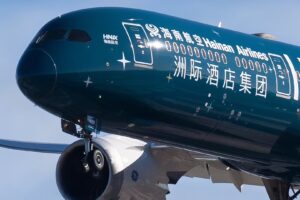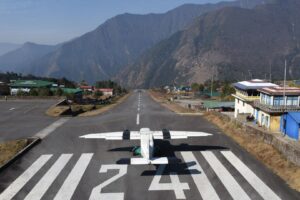
The world’s airports continue to deliver on sustainability, achieving new milestones and pioneering new green initiatives, writes Joe Bates.
NEW AIRPORT CARBON ACCREDITATION HIGH FOR NARITA
In another step towards net zero, Tokyo’s Narita International Airport has successfully upgraded to Level 4 ‘Transformation’ status in ACI’s Airport Carbon Accreditation programme.
Narita operator, NAA, has set comprehensive decarbonisation targets for both itself and the wider airport community through its ‘Sustainable NRT 2050’ strategy.
One of the cornerstones of its strategy is the Narita International Airport Decarbonisation Promotion Plan, making it the first airport in Japan to set forth numerical targets on CO2 reduction for the entire airport.
As a result, the NAA Group has committed to converting 20% of its purchased electricity to renewable energy by 2030, with the aim of transitioning entirely to renewable energy by 2050.
All lighting within terminal buildings, aeronautical systems, and other facilities will be replaced with energy-efficient LEDs by 2030 – amounting to over 200,000 individual lights.

The airport has also established Green Energy Frontier Co Ltd in order to contribute to decarbonisation efforts by supplying electricity and thermal energy.
In addition, it has installed a 2MW solar power generation system on the roof of a new cargo shed as part of the first phase of its mega solar project.
Narita International Airport is further addressing operational emissions by halving GPU usage time from 30 minutes to 15 minutes before departure and conducting trials with renewable diesel fuel for specialised vehicles, such as fire engines.
The forward looking airport has also implemented measures to support Sustainable Aviation Fuels.
GIANT NEW SOLAR FARM AT ROME’S FIUMICINO AIRPORT
Aeroporti di Roma (ADR) has inaugurated its new solar farm at Rome Fiumicino, which instantly becomes one of the largest photovoltaic systems in the world on airport land.
The solar farm is located along the eastern side of Runway 3 at Rome Fiumicino and takes its renewable energy efforts to the next level.
The new infrastructure was designed by ADR and built by Enel in collaboration with Circet, following a European public tender after which the integrated contract was assigned.
It extends for almost 2.5 kilometres and is made up of approximately 55,000 silicon panels.
With a capacity of 22MWp (measure of the power output of the system), it will allow the airport to produce approximately more than 30 million kWh (measure of the energy production potential) of electricity per year.
According to ADR, this launch represents a first, significant step towards the airport reaching an installed power of 60MWp in the next five years, with the installation of additional solar farms within the perimeter of the current area.

Such capacity would be enough to satisfy the annual energy needs of around 30,000 Italian households for an entire year, or – in terms of electric cars – to fully charge approximately one million vehicles.
Approximately €50 million have been invested in total for the implementation of the project, which is part of a portfolio of initiatives for renewable energy generation and sustainable mobility with a financial commitment exceeding €200 million.
The solar farm, which is expected to help reduce the airport’s CO2 emissions by over 11,000 tons per year, is one of the most ambitious initiatives implemented by ADR in the context of its strong commitment to energy transition and decarbonisation . The goal, ultimately being to achieve net zero carbon emissions by 2030 – a full 20 years ahead of the industry’s target.
“The launch of the new solar farm strengthens our commitment to the green transition and decarbonisation, with an infrastructure that is unique in the international airport landscape,” stated ADR CEO, Marco Troncone.
JFK DOUBLES ITS NUMBER OF ELECTRIC VEHICLE CHARGERS
The Port Authority of New York & New Jersey has unveiled a new charging station at John F Kennedy International Airport (JFK) that more than doubles the airport’s available electric vehicle (EV) chargers.
Located within the airport’s for-hire vehicle (FHV) hold lot and installed by Revel and Con Edison, the new facility is equipped with 24 EV chargers.
The additional chargers help meet growing demand for electric vehicle charging infrastructure at Port Authority facilities, which support the agency’s industry-leading sustainability initiatives.
It has specified plans to reach its ambitious goal of achieving net-zero carbon emissions by 2050 through its comprehensive net-zero roadmap. That goal encompasses both the agency’s own emissions as well as those originating through the wider transportation ecosystem supporting its facilities.
“As we work toward a cleaner, more sustainable future, expanding access to electric vehicle charging infrastructure is a crucial step in reducing emissions,” said Port Authority chairman Kevin O’Toole. “These fast chargers at JFK are a significant step forward in our broader efforts to support a greener transportation network.”
NEWCASTLE AIRPORT SHOWS GREEN CREDENTIALS
Newcastle Airport has set a new benchmark in Australian aviation sustainability by becoming the first airport in the country to achieve Level 4+ ‘Transition’ status in ACI’s Airport Carbon Accreditation (ACA) programme, placing it among the top 12% of airports worldwide.
The gateway noted that achieving Level 4+ Transition accreditation supported the Australian government’s ‘Future Made in Australia’ plan to achieve net zero emissions by 2050, and highlighted the success of its long-term, strategic approach to reducing the airport’s carbon footprint.
“Level 4+ recognises that we are truly transitioning away from carbon reliance and embedding sustainability into our long-term future,” enthused interim CEO, Andrew Warrender .
“Newcastle Airport is leading the way globally; it’s important that airports can also contribute to net zero targets in the aviation industry through our provision of green infrastructure, whilst airlines focus on Sustainable Aviation Fuel and hydrogen jet technology.
“We are committed to being the Green Gateway to NSW, and contributing to our region’s efforts in renewable innovation and move towards transforming the Hunter Region into a leading hub for clean energy production, storage, and export via the hydrogen Hub in Newcastle and the Port of Newcastle’s Clean Energy Precinct.”

ALL TIME HIGH FOR RECYCLING AT BHX
Birmingham Airport (BHX) in the UK is celebrating its most waste efficient year ever with its recycling rate for terminal operations exceeding 75%.
Year-on-year, the airport’s recycling rate for main terminal waste was 76%, the highest annual figure to date.
Last year, BHX became the first airport worldwide to implement a Mobile Segregation Unit (MSU) to help sustainably process waste: an innovative solution that has helped prevent over 1,200 tonnes of waste from becoming non-recyclable general waste.
The unit facilitates a targeted data-driven approach to waste management and has supported the airport in significantly exceeding its previous strategic commitment of recycling 65% of waste. As a result of the system, the airport’s recycling rate is on track to be one of the highest amongst UK airports.
In addition to recycling, the MSU also supports the reuse and donation of certain items that are left by customers.
From pushchairs to toiletries, 36.2 tonnes of items were donated in the same period to local charities including Let’s Feed Brum, Tots in Need and St Basils.
Commenting on the record year, Tom Denton, BHX’s head of sustainability, said: “Achieving a 20% increase in our recycling rate in just one year is illustrative of the impact that the unit has had in reducing our environmental impact.”
NEW ZEALAND’S FIRST ELECTRIC FIRE TRUCK LANDS IN CHRISTCHURCH
Christchurch Airport has taken another significant step in its commitment to operational excellence and sustainability, taking possession of New Zealand’s first electric fire truck.
The Rosenbauer RT (Revolutionary Technology) is also the first electric fire truck at any airport in the Southern Hemisphere, reinforcing the airport’s leadership in sustainable airport practices.
The arrival of the new vehicle is part of the airport’s broader fleet transition programme. With the corporate fleet already 100% electric, the airport is now transitioning its emergency response vehicles as part of its commitment to a zero-emission fleet by 2035.
Airport chief executive, Justin Watson, said: “Safety is at the heart of everything we do, and this new truck ensures our emergency response teams have cutting-edge equipment to keep the airport community safe.
“At the same time, this is another step towards our zero-emissions goal. Innovation and responsibility go hand in hand. By investing in world-class emergency response technology, we’re ensuring our airport remains at the forefront of both safety and environmental leadership.”
LEED SILVER CERTIFICATION FOR SJC’S NEW FACILITIES
San José Mineta International Airport (SJC) is celebrating Leadership in Energy and Environmental Design (LEED) Silver certification of its new, 22,600 square foot Facilities Administration and Fleet Maintenance Buildings.
The state-of-the-art facilities were designed and built by the same team behind the LEED Silver-certified Aircraft Rescue and Firefighting Facility (ARFF), completed in March 2022.
SJC’s director of aviation, Mookie Patel, said: “We are committed to environmental stewardship, and I am very proud of the strides that we have made thus far in our sustainability journey, with more to come.
“This LEED Silver Certification comes just months after SJC’s Level 2 certification in the Airport Carbon Accreditation programme. We are grateful to the City of San José for their support with this project, and to Overaa Construction and MARJANG Architecture for bringing SJC’s vision of a modern, sleek and eco-friendly building to life.”
The Facilities Administration and Fleet Maintenance Buildings consists of two buildings: a one-story maintenance facility – allowing airport vehicles to be serviced onsite – and a two-story building with trade shops on the first floor and administrative offices on the second floor. It also includes 65,000 square feet of site area.




